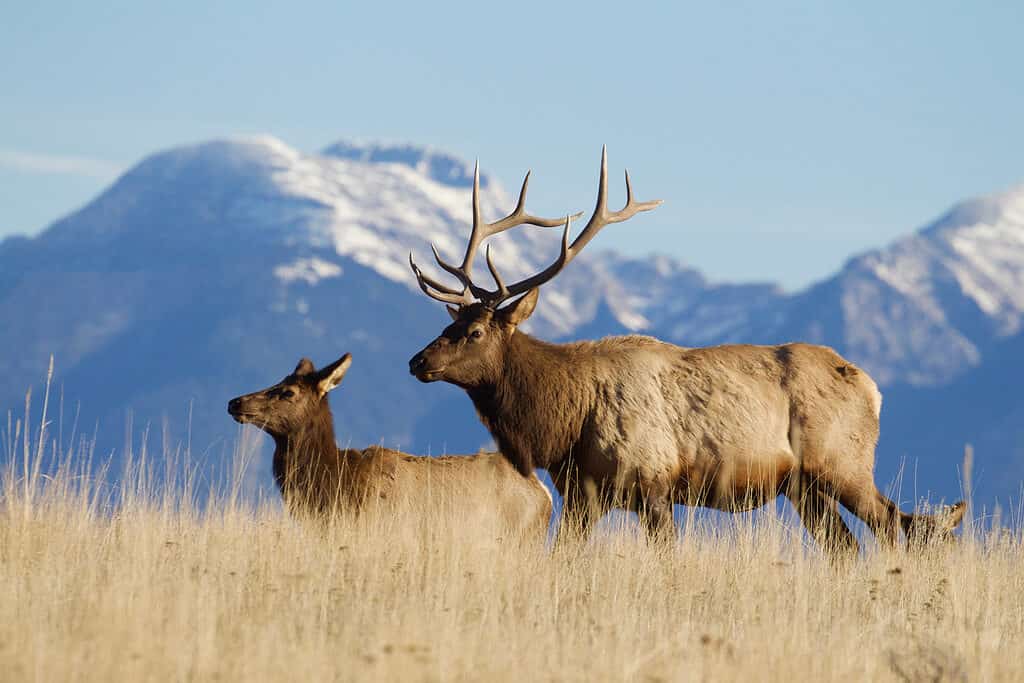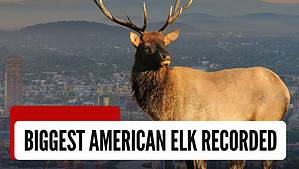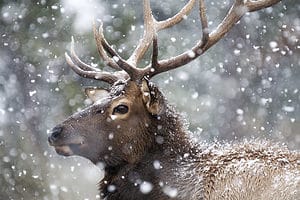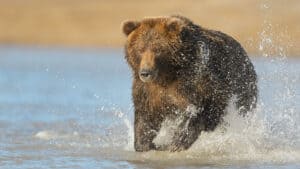Also known as wapiti, American elk are the second-largest deer family member. They’re found across North America. With size on its side, you will be surprised to learn the exact record of the largest American elk ever caught in Montana.
They are known for their massive antlers, which can weigh up to 40 lbs. and span up to 5 ft. Their meat is lean, flavorful, and highly sought after by hunters and food enthusiasts.
Montana is renowned for its elk hunting, and for a good reason. With over 150,000 elk in the state, it’s a popular destination for hunters worldwide.
Hunting has been integral to Montana’s culture and economy for centuries. As a result, the state has a long history of responsible conservation practices to ensure that elk populations remain healthy and sustainable.
In this article, we discover the largest American elk ever caught in Montana. We’ll also learn more about this remarkable animal, including its status in Montana State.
The Largest American Elk Ever Caught in Montana
The largest American elk ever caught in Montana scored an impressive 431 7/8. Hunter Garth W. Sessions caught the non-typical American elk in 2016. The catch, owned by Garth W. Sessions, also holds the record as the largest non-typical American elk ever caught in the state.
The largest typical elk ever caught in Montana scored 430, making it the second-largest American elk ever recorded in Montana. Stephan F. Felix, who owns the trophy, caught the elk in 2016.

The largest American elk ever caught in Montana scored 431 7/8.
©Bradley Wakoff/Shutterstock.com
The Largest American Elk Ever Caught Worldwide
The world’s record of the largest American elk ever caught scored an astounding 499 3/8 points. Denny Austad shot and killed the web-antlered non-typical American elk in south-central in 2008.
American Elk in Montana
American elk have a huge presence in Montana, making it one of the top states in the country for elk hunting and wildlife watching.
Overview of American Elk
American elk are known for their impressive physical characteristics. They can weigh up to 1,000 lbs. and stand over 5 ft. tall at the shoulder.
Male elk, known as bulls, have large antlers, which can grow up to 4 ft. long, and weigh over 40 lbs.
Elk are social animals, typically living in large herds. But they can be found in smaller groups or as solitary individuals.
History of Elk in Montana
Before European settlement, it’s estimated that there were as many as a million elk in what’s now Montana State. But hunting and habitat loss due to agriculture and development caused elk populations to decline significantly by the early 1900s.
In response to these declines, wildlife management agencies in Montana began to implement measures to protect and manage elk populations.
One of the earliest and most significant efforts was establishing Yellowstone National Park in 1872. It provided a protected habitat for elk and other wildlife.
In the decades that followed, Montana’s elk populations slowly began to recover.
Recovery of Elk Populations
Montana’s elk populations have rebounded significantly, with an estimated 120,000 to 150,000 elk in the state. Montana Fish, Wildlife & Parks (FWP) manages elk populations using a combination of:
- Science-based research
- Public input
- Careful monitoring
Current Challenges Facing Elk in Montana
While elk populations in Montana have rebounded significantly since the early 1900s, there are still challenges facing these majestic animals.
- Climate change. Climate change is one major factor affecting elk populations, as changing weather patterns can impact elk habitat and behavior.
- Habitat loss. Habitat loss and fragmentation due to development and land use are also significant threats, as they can limit the availability of suitable elk habitats.
- Predation. Predation by wolves and other predators can also affect elk populations.

American Elk in Montana can weigh up to 1,000 pounds and stand up to five feet tall at the shoulder.
©Tom Reichner/Shutterstock.com
American Elk Predators
The American elk have several natural predators. Let’s take a look at some of them.
Gray Wolves
Gray wolves are one of the primary predators of elk in Montana. As a result, their reintroduction into the state has significantly impacted elk populations.
Mountain Lions
Also known as cougars or pumas, mountain lions are another common predator of elk in Montana. They typically hunt elk calves or weakened adult elk.
Black Bears
While black bears are not known to regularly prey on adult elk, they may opportunistically target elk calves or scavenge on elk carcasses.
Grizzly Bears
Like black bears, grizzly bears may prey on elk calves or scavenge on elk carcasses. Still, they occasionally kill adult elk.
Coyotes
While coyotes are not typically a significant threat to adult elk, they may prey on elk calves or scavenge on elk carcasses.
Current Status of Elk in Montana
Montana is known for its stunning landscapes and abundant wildlife. One of the most iconic species found here is the American elk. These majestic animals can be seen roaming through the state’s forests, meadows, and mountains, delighting locals and visitors.
Despite their enduring popularity, the health and well-being of Montana’s elk populations face several challenges that could impact their long-term survival.
Population
As mentioned earlier, Montana is home to an estimated 120,000-150,000 American elk. They’re distributed across the state, although populations are generally concentrated in the western and central regions.
Hunting and Management
Elk hunting is an important tradition and economic driver in Montana. Each year, the state sets hunting quotas based on population estimates and the health of local herds. The hunting season runs from early September to mid-December, with different regulations and seasons for other hunting districts.
The FWP closely monitors the number of elk harvested yearly to ensure that the overall population remains healthy.
In addition to hunting, the FWP manages elk populations through habitat protection and management. The agency works to protect important elk habitats, such as winter ranges and migration corridors. It also manages conflicts between elk and humans.
For example, the FWP may use fencing or other deterrents to prevent elk from damaging crops or other property.

The largest American elk ever caught in Montan also holds the record as the largest non-typical American elk ever caught in the state.
©Virrage Images/Shutterstock.com
American Elk Hunting in Montana
Elk hunting is a time-honored tradition that has deep cultural roots in Montana. Thousands of hunters travel to Montana each year to pursue these magnificent animals. They are usually drawn by the thrill of the chase and the opportunity to test their skills and knowledge against one of North America’s largest and most powerful animals.
Hunting Regulations
To hunt elk in Montana, a hunter must possess a valid elk license obtained through a lottery system.
The lottery is conducted in the spring. Selected hunters are issued a license for a specific hunting district and period.
The number of licenses issued each year is based on the estimated size of the elk population in each district and the herd’s health.
Hunting Methods
Elk hunting methods include both rifle and archery. Hunters are typically required to follow specific rules and regulations for each method.
Montana’s elk populations are distributed across the state. Hunters often travel to remote and rugged areas to pursue these animals. Because elk are large and powerful animals, hunting them requires skill, patience, and the ability to navigate difficult terrain. Successful hunters often have extensive knowledge of elk behavior, habitat, and seasonal movements. They may spend weeks or even months scouting and preparing for their hunt.
Ethics and Safety
American elk hunting in Montana is a highly regulated activity. Hunters are expected to follow ethical and safety guidelines to ensure the health and sustainability of the state’s elk populations.
Hunters must obtain the necessary licenses and permits, follow specific hunting regulations and quotas, and report their harvests to the FWP. They are also expected to follow ethical guidelines, such as minimizing the suffering of animals and avoiding wasteful harvests.
Safety is a critical concern when hunting elk in Montana. Hunters must:
- Wear brightly colored clothing
- Use appropriate hunting methods and equipment
- Follow other safety guidelines to avoid accidents and injuries
Economic and Cultural Significance
Elk hunting is an important cultural tradition in Montana and has significant economic benefits for the state.
The hunting industry generates millions of dollars in revenue annually, supporting local businesses, outfitters, and guides.
Hunting also contributes to the state’s overall tourism industry. It attracts visitors from around the country and worldwide who come to experience Montana’s natural beauty and abundant wildlife.
Elk-Watching Opportunities in Montana
While hunting elk is a popular activity in Montana, many visitors and locals also enjoy observing these magnificent animals in their natural habitat.
Fortunately, Montana offers numerous opportunities for elk-watching, from wildlife tours and photography workshops to hiking and camping in elk-rich areas.
Best Places to Observe Elk
Some of the best places to observe elk in Montana include:
- The Charles M. Russell National Wildlife Refuge
- Yellowstone National Park
- The National Bison Range
These areas are home to large elk populations and offer a range of observation opportunities, from guided tours and wildlife drives to backcountry hikes and camping trips.
Other popular elk-watching areas in Montana include:
- The Bitterroot Valley
- The Gallatin Valley
- The Ruby Valley
Each of these areas offers a unique blend of natural beauty, wildlife diversity, and cultural attractions. This makes them ideal destinations for nature enthusiasts and wildlife photographers.
Best Times to Observe Elk
The best times to observe elk in Montana vary depending on the season, weather, and location.
In general, the fall is the best time to see elk. This is when the breeding season, or “rut,” takes place. During the rut, male elk compete for the attention of females, often engaging in dramatic displays of dominance and aggression.
Spring and summer are also excellent times to observe elk in Montana. This is when the calves are born, and the herds are often more visible in open areas.
Elk are more difficult to observe in winter, as they tend to move to lower elevations and denser forests to avoid harsh weather conditions.
Tips for Elk-Watching
Visitors should follow a few basic tips and guidelines to ensure a safe and enjoyable elk-watching experience in Montana. Here are a few of them:
- Respect wildlife and their habitat. Visitors should avoid approaching elk too closely, making loud noises, or otherwise disturbing their natural behavior.
- Stay safe. Visitors should always maintain a safe distance from elk, particularly during the rut. They should carry bear spray, make noise if the animals charge at them, and stay alert for other wildlife in the area.
- Choose the right gear. Visitors should bring appropriate clothing, binoculars, cameras, and other equipment to help them observe elk safely and comfortably.
- Research ahead of time. Visitors should research the best times and places to observe elk in Montana and consider joining a guided tour or workshop for a more in-depth experience.

The state of Montana is home to one of the largest elk populations in North America.
©Chase Dekker/Shutterstock.com
Where Is Montana Located On a Map?
The State of Montana is found in the Northwestern region of the continental United States. It shares a border with Idaho, Wyoming, North and South Dakota, as well as Canada.
Key Takeaways
The largest American elk ever caught in Montana was in 2016 and scored 431 7/8. Montana is home to one of North America’s largest and healthiest elk populations. That makes it an ideal destination for elk hunting, elk-watching, and wildlife conservation. As we have explored in this article, elk have played a vital role in Montana’s history and culture, serving as a symbol of the state’s natural beauty and rugged spirit.
But elk populations and hunting opportunities in Montana face many challenges, from habitat loss and disease to social and political conflicts over wildlife management. Montana residents, visitors, and wildlife experts can help ensure elk populations remain strong and sustainable for future generations by working together to address these challenges.
Whether you are a hunter, a wildlife photographer, or a nature enthusiast, Montana’s elk populations offer endless opportunities for adventure, discovery, and awe-inspiring experiences. By respecting wildlife, following ethical hunting and wildlife-watching practices, and working to protect Montana’s natural heritage, we can all play a part in ensuring that elk continue to thrive in the Treasure State.
The photo featured at the top of this post is © Tony Campbell/Shutterstock.com
Thank you for reading! Have some feedback for us? Contact the AZ Animals editorial team.






